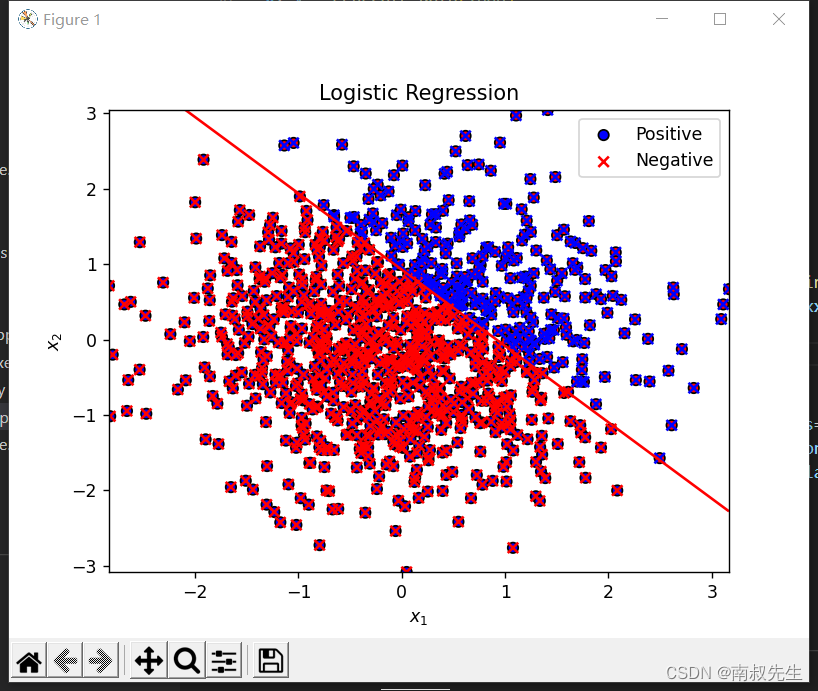一、Python
import numpy as np
import matplotlib.pyplot as plt
# 定义sigmoid函数
def sigmoid(x):
return 1 / (1 + np.exp(-x))
# 定义训练函数
def train(X, y, learning_rate, epochs):
m, n = X.shape # 获取数据集大小和特征数量
theta = np.zeros(n) # 初始化权重
for i in range(epochs): # 迭代训练
z = np.dot(X, theta) # 计算z值
h = sigmoid(z) # 计算预测值
gradient = np.dot(X.T, (h - y)) / m # 计算梯度
theta -= learning_rate * gradient # 更新权重
return theta
# 定义生成数据函数
def generate_data(num_examples):
# 生成随机特征和标签
X = np.random.normal(0.0, 1.0, (num_examples, 2))
y = np.zeros(num_examples)
for i in range(num_examples):
if X[i][0] + X[i][1] > 1:
y[i] = 1
return X, y
# 生成数据集
X, y = generate_data(1000)
# 标准化特征
X = (X - np.mean(X, axis=0)) / np.std(X, axis=0)
# 添加偏置项
X = np.hstack((np.ones((X.shape[0], 1)), X))
# 训练模型
theta = train(X, y, learning_rate=0.1, epochs=1000)
# 输出训练结果
print("theta: ", theta)
# 定义预测数据
x1_min, x1_max = X[:, 1].min(), X[:, 1].max()
x2_min, x2_max = X[:, 2].min(), X[:, 2].max()
xx1, xx2 = np.meshgrid(np.linspace(x1_min, x1_max), np.linspace(x2_min, x2_max))
X_pred = np.hstack((np.ones((xx1.ravel().shape[0], 1)), xx1.ravel().reshape(-1, 1), xx2.ravel().reshape(-1, 1)))
# 预测结果
y_pred = sigmoid(np.dot(X_pred, theta))
y_pred = y_pred.reshape(xx1.shape)
# 绘制训练数据和预测结果
plt.scatter(X[:, 1], X[:, 2], c=y, cmap='bwr', edgecolors='k', label='Positive') # 绘制正例散点图
plt.scatter(X[:, 1], X[:, 2], c=1-y, cmap='bwr', edgecolors='k', marker='x', label='Negative') # 绘制反例散点图
plt.contour(xx1, xx2, y_pred, levels=[0.5], colors='r', label='Decision Boundary') # 绘制决策边界等高线图
plt.legend() # 添加图例
plt.xlabel(r'$x_1$') # 添加x轴标签
plt.ylabel(r'$x_2$') # 添加y轴标签
plt.title('Logistic Regression') # 添加标题
plt.show() # 显示图形

二、C++
#include <iostream>
#include <vector>
#include <cmath>
#include <cstdlib>
#include <ctime>
using namespace std;
// 定义sigmoid函数
double sigmoid(double x) {
return 1.0 / (1.0 + exp(-x));
}
// 定义训练函数
vector<double> train(vector<vector<double>>& X, vector<double>& y, double learning_rate, int epochs) {
int m = X.size(); // 获取数据集大小
int n = X[0].size(); // 获取特征数量
vector<double> theta(n, 0.0); // 初始化权重
for (int i = 0; i < epochs; i++) { // 迭代训练
vector<double> z(m, 0.0); // 初始化z值
vector<double> h(m, 0.0); // 初始化预测值
for (int j = 0; j < m; j++) {
for (int k = 0; k < n; k++) {
z[j] += X[j][k] * theta[k]; // 计算z值
}
h[j] = sigmoid(z[j]); // 计算预测值
}
vector<double> gradient(n, 0.0); // 初始化梯度
for (int j = 0; j < n; j++) {
for (int k = 0; k < m; k++) {
gradient[j] += X[k][j] * (h[k] - y[k]); // 计算梯度
}
gradient[j] /= m;
theta[j] -= learning_rate * gradient[j]; // 更新权重
}
}
return theta;
}
// 定义生成数据函数
void generate_data(vector<vector<double>>& X, vector<double>& y, int num_examples) {
srand(time(NULL)); // 设置随机种子
for (int i = 0; i < num_examples; i++) {
double x1 = (double)rand() / RAND_MAX;
double x2 = (double)rand() / RAND_MAX;
X[i] = {1.0, x1, x2}; // 添加偏置项
if (x1 + x2 > 1) {
y[i] = 1.0;
} else {
y[i] = 0.0;
}
}
}
int main() {
int num_examples = 1000; // 数据集大小
vector<vector<double>> X(num_examples, vector<double>(3, 0.0)); // 特征矩阵
vector<double> y(num_examples, 0.0); // 标签向量
generate_data(X, y, num_examples); // 生成数据集
double learning_rate = 0.1; // 学习率
int epochs = 1000; // 迭代次数
vector<double> theta = train(X, y, learning_rate, epochs); // 训练模型
cout << "theta: ";
for (int i = 0; i < theta.size(); i++) {
cout << theta[i] << " ";
}
cout << endl;
return 0;
}
